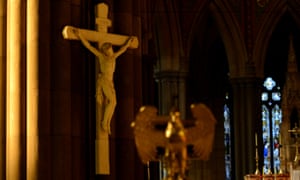 Victims’ groups have warned that data on reports of child sexual abuse within the Catholic church, while shocking, still underestimates the scale of offending.
Victims’ groups have warned that data on reports of child sexual abuse within the Catholic church, while shocking, still underestimates the scale of offending. On Monday the royal commission into institutional responses to child sexual abuse released damning statistics on the number of allegations of sexual predation the church was aware of.
Counsel assisting the commission, Gail Furness SC, said between January 1980 and February 2015 4,444 people made allegations of sexual abuse to 93 church authorities.
On average the gap between the alleged abuse and the report was 33 years.
“A total of 1,880 alleged perpetrators were identified in claims,” Furness said. “Over 500 unknown people were identified as alleged perpetrators.”
Bernard Barrett, a researcher with Broken Rites, a website documenting Catholic abuse, said the figures were only indicative of the minimal number of perpetrators.
“It’s more than that. At least that many were offenders, that’s the very least,” Barrett told Guardian Australia. “The numbers are very seductive; people think that it’s an exact figure when, in reality, it’s indicative.
“The church has covered up a lot of the abuse, as they have done for 2000 years.”
One survivor of abuse within the Marist order, Damian De Marco, said he had become sceptical of the church’s willingness to change.
De Marco was abused at Marist College in Canberra and has since campaigned for stronger child protection, including the implementation of reportable conduct schemes across the country.
De Marco said the abuse crisis playing out in Australia was following far behind similar scandals across the world.
Despite that, he said the church still had not changed the root cultural causes of abuse within its ranks, such as celibacy or a male-only priesthood.
“I’ve become a sceptic because America has passed us by, Spotlight has passed us by, Ireland has passed us by,” De Marco told Guardian Australia. “They’re going to tinker around the edges and carry on and children are going to continue to be abused.”
Vlad Selakovic, a survivor of abuse at one of Salvation Army’s boys’ homes, said shame was still keeping many survivors from coming forward.
Selakovic, a member of the Care Leavers Australasia Network, agreed the numbers were likely to be well below the reality. “That’s still not the total number, there are a lot more people out there who refuse to come forward,” Selakovic said outside the royal commission in Sydney.
“A lot of people out there still carry that shame factor and refuse to come forward because they don’t want friends and family to realise that they were one of those people.”
The church’s Truth, Justice and Healing Council, set up to coordinate its response to the crisis, made an opening statement following the release of the data on Monday.
“These numbers are shocking, they are tragic, they are indefensible,” said the council’s chief executive, Francis Sullivan. “And each entry in this data for the most part represents a child who suffered at the hands of someone who should have cared for and protected them.
“The data is an indictment on the priests and religious who abused these children. It also reflects on the church leaders who at times failed to take steps to deal with the abusers, failed to call them to order and failed to deal with them in accordance with the law.”
The royal commission is now in its final stage of examining abuse by Catholic clergy and the responses of various Catholic authorities.
The final three weeks are expected to focus on cultural causes of the offending, the current child protection policies of the church and the way it has responded to the royal commission case studies so far.
